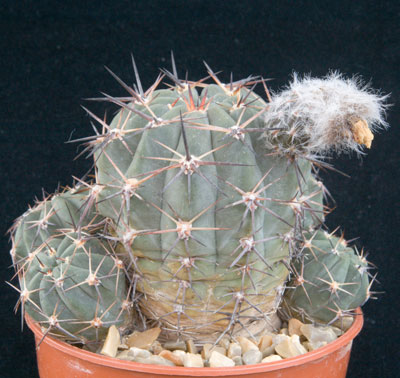First described in 1931 Lobivia chrysantha is for me perhaps the doyen of all Lobivias. Its author, Erich Werdermann, chose the epithet ‘chrysantha’ (golden flower) with remarkable precision as flower colour in this species is a nearly constant characteristic. The flowers are also large; they open to about 6cm in diameter and have a deep purple-black throat. On further careful inspection it can be seen that this coloration arises from the filaments of the inner series of stamens which adhere to the inside flower tube.

Fig. 1 Lobivia chrysantha
Other appealing characteristics of the species include its matt glaucous blue epidermis and contrasting short white radial spines. There are generally 1–3 equally short central spines but these are nearly always black and slightly bulbous at their base. For those with limited greenhouse space it has the extra attraction of being a small, slow-growing species, taking perhaps ten years (if you grow it hard like me) to reach maturity yet still only needing a 10cm pot. The pot will need to be deep however as the plants will produce a large tap root.

Fig. 2 A flowering plant
Lobivia chrysantha grows, unexpectedly for a Lobivia, in one of the most inhospitably dry valleys of northern Argentina, the Quebrada del Toro of Salta province. The average annual rainfall there is about 190mm, indeed for eight months of the year it receives barely any rain at all, only about 30mm in total! The highest rainfall, ~60mm, and temperatures, ~20C, occur together in January which is when the plants flower. It shares this habitat with several other, equally desirable cacti: Lobivia ferox, Maihueniopsis mandragora, Parodia steumeri, Pyrrhocactus umadeave and Trichocereus pasacana.

Fig. 3 Flower closeup
Propagation is best done from seeds but do not transplant the seedlings for a couple of years, and then not unless the roots are completely dry. Subsequent cultivation is relatively simple: use a free-draining compost and take care in watering because of the tap root. Like most Lobivias it will tolerate temperatures below freezing in the winter if dried off during September.

Fig. 4 Lobivia chrysantha in habitat
Martin Lowry
No part of this article or the accompanying pictures may be reproduced without permission
